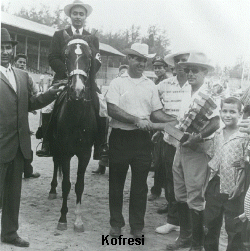A beautiful horse of proud Spanish heritage…
The ancestors of today’s Paso Fino were transported in 1493 to the New World on Cristopher Columbus’ second voyage to the New World. He brought with him a mixture of Barbs (a hardy breed from North Africa), Spanish Jennets (a gaited horse now distinct)and beautiful Andalusians from the Spanish provinces of Andalusia and Cordela and settled them at Santa Domingo (now the Dominican Republic).
Bred for their stamina, smooth gait and beauty, their offspring became the foundation stock for remount stations of the Conquistadors. Over time, because of of its smooth “no-bounce” ride, the breed became known as the “Los Caballos de Paso Fino” which means “the horse with the fine step”. This name was later shortened to Paso Fino…simply meaning “fine step”. The Paso Fino continued to flourish being found primarily in Puerto Rico, Colombia, Cuba, Dominican Republic, Aruba and Venezuela.
Awareness of the Paso Fino, as we know it today, didn’t spread outside Latin America until after WWII when American servicemen came into contact with the stunning Paso Fino horse while stationed in Puerto Rico. In the mid-1940’s, the importation of the Puerto Rican Paso Fino into America began. It wasn’t until two decades later that the Columbian Paso Fino was imported.
Ever since that time, contention has existed between some purists as to which country produced the “truest” Paso Fino because of the slight differences between the two strains. However, a mix of strains, sometimes called the American Paso Fino even though there is no registry for such, also exists and is a reflection of our nation as a “melting pot”. The mix, or the American Paso Fino if you’d rather, is often a wonderful blend of the best Puerto Rican and Columbian bloodlines.
Puerto Rican Paso Fino Hstory…
In 1509 Juan Ponce de Leon, then governor of Puerto Rico, brought the first horses from La Espanola Dominican Republic) to Puerto Rico and hence began the Islands love affair with the Paso Fino breed. Specific bloodlines were bred with a vision that would benefit Island plantation owners and cattlemen. Through careful selection and dedicated, their breeding principles contributed to the foundation of the Puerto Rican Paso Fino.
The Puerto Rican Paso Fino differs from the Columbian Paso Fino in that it typically has lighter frame and it’s heritage was originally/solely founded on a low, quick, soft-stepping, evenly timed (1-2-3-4) footfall with a very naturally smooth gait absent of a diagonal execution (trot). During execution of their gait, three hooves touch the ground at the same time while one is in the air; as the one in the air touches the ground, one new hoof will leave.
Columbian Paso Fino History…
The Columbian Paso Fino is very beautiful, and it originates from two types of Pasos that were bred in order to accommodate different terrains.
-The first type was for use on the plains and in swampy areas; these Pasos had wide hooves and executed front leg action that is today called, termino. Termino is an outward rolling, at the shoulders and/or anterior and lateral rotation around the axes in the knee and fetlock, of the front limbs during extension.
-The second type was bred for use in the mountains; these Pasos executed a smooth “pistoneo” gait, which is a front and hind action that resembles a piston-like up and down movement preferred for balance on uneven terrain.
Summary…
After generations of dedication and selective breeding in Puerto Rico and Columbia, the Paso Fino became and remains a very unique, versatile and extraordinary beautiful equine athlete that effortlessly captures the hearts of many. The different strains within the breed also offer a variety of special characteristics that help make it possible to find a special smooth riding companion that can meet, or exceed, most all expectations/needs.
Today’s Paso Fino breed, in general, continues to reflect its Spanish heritage through its proud carriage, elegance and natural smooth four-beat gait. The Paso Fino gait is performed at three speeds known as the Classic Fino, Paso Corto and Paso Largo. The length of stride and degree of collection varies respectively with Classic Fino being fully collected with the shortest stride and Paso Largo being the longest stride. Smoothness, speed, length/range of stride and collection abilities are governed by the horse’s conformation and genetic natural abilities.
Please visit the Paso Fino Horse Assocation (PFHA) website for further information about the breed’s history, gait, breed standards, and more!


